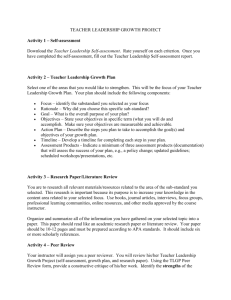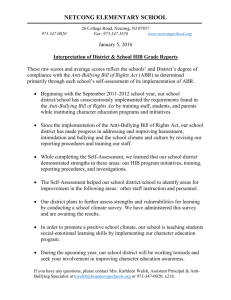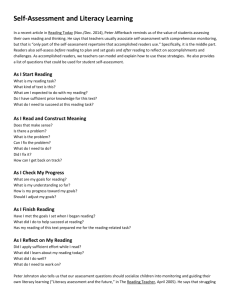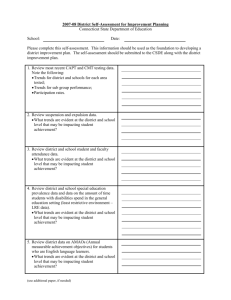Human Services Standards self-assessment report and quality
advertisement
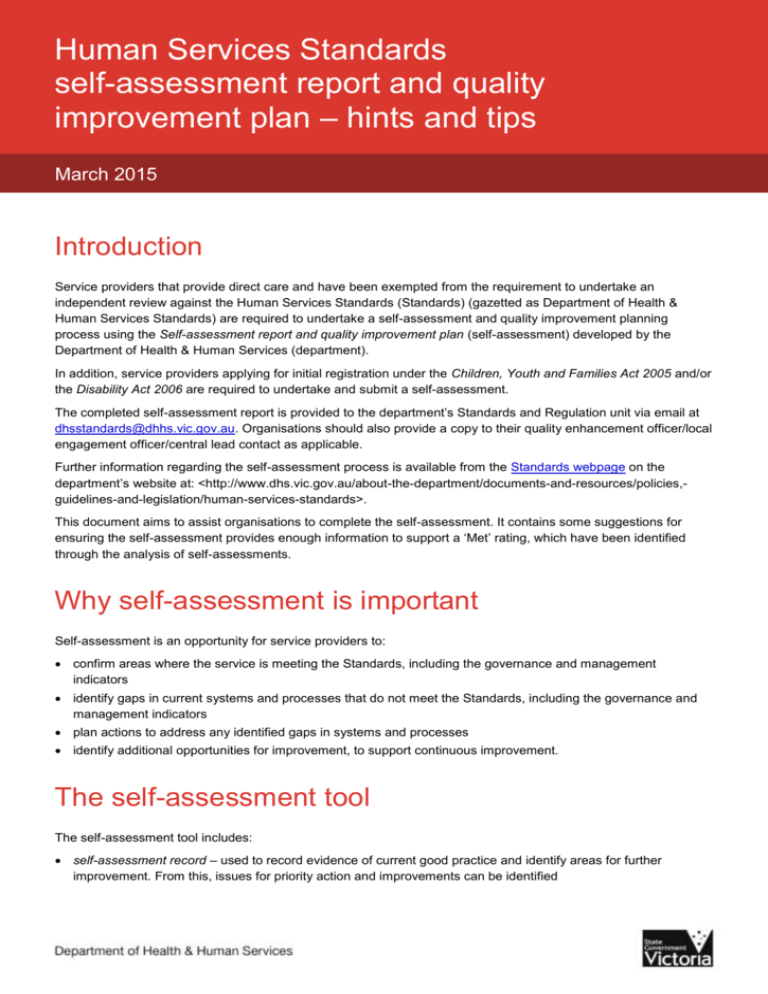
Human Services Standards self-assessment report and quality improvement plan – hints and tips March 2015 Introduction Service providers that provide direct care and have been exempted from the requirement to undertake an independent review against the Human Services Standards (Standards) (gazetted as Department of Health & Human Services Standards) are required to undertake a self-assessment and quality improvement planning process using the Self-assessment report and quality improvement plan (self-assessment) developed by the Department of Health & Human Services (department). In addition, service providers applying for initial registration under the Children, Youth and Families Act 2005 and/or the Disability Act 2006 are required to undertake and submit a self-assessment. The completed self-assessment report is provided to the department’s Standards and Regulation unit via email at dhsstandards@dhhs.vic.gov.au. Organisations should also provide a copy to their quality enhancement officer/local engagement officer/central lead contact as applicable. Further information regarding the self-assessment process is available from the Standards webpage on the department’s website at: <http://www.dhs.vic.gov.au/about-the-department/documents-and-resources/policies,guidelines-and-legislation/human-services-standards>. This document aims to assist organisations to complete the self-assessment. It contains some suggestions for ensuring the self-assessment provides enough information to support a ‘Met’ rating, which have been identified through the analysis of self-assessments. Why self-assessment is important Self-assessment is an opportunity for service providers to: confirm areas where the service is meeting the Standards, including the governance and management indicators identify gaps in current systems and processes that do not meet the Standards, including the governance and management indicators plan actions to address any identified gaps in systems and processes identify additional opportunities for improvement, to support continuous improvement. The self-assessment tool The self-assessment tool includes: self-assessment record – used to record evidence of current good practice and identify areas for further improvement. From this, issues for priority action and improvements can be identified assessment matrix – a summary of the findings and ratings of the self-assessment against the Standards including the governance and management standards quality improvement plan – a summary of the actions required to meet the indicators and identified improvement opportunities checklist of actions – provided to assist review of the completed self-assessment prior to submitting to the Standards and Regulation Unit and the local engagement officer, quality enhancement officer or central department contact. Hints and tips Following are some suggestions to support the completion of the self-assessment. Note there is detailed information for how to complete the self-assessment tool and what each section requires in the tool itself. The tool is available from the department’s website at the link in ‘Introduction’ above. The self-assessment must demonstrate the service provider’s compliance with the Standards. A service provider, where exempt from an independent review, may only rate itself as partially compliant against the Standards at the time of submitting its self-assessment at 18 months. Where this occurs, the service provider must demonstrate full compliance with the Standards at the time it submits its self-assessment at the end of the service agreement period or at the time of applying for renewal of registration. In order to achieve compliance against the Standards, the self-assessment defines a ‘Met’ rating as ‘written and verbal evidence clearly demonstrates that the service provider meets all the requirements of the criteria’. Good practice examples The self-assessment clearly demonstrates how processes work in practice. Graphs and/or results of surveys are included. Examples of survey questions are included. Documents and descriptions meet the particular criteria. As needed, evidence of processes related to staff are clearly distinguished from those related to clients. Details regarding the timelines, responsibility, reporting and processes are included. Acronyms are listed in full at first use or an acronyms list is provided. Documents are described as required, for example when information relating to managing client’s finances is included in the ‘House Manual’, this is clearly identified. Training undertaken is listed, rather than referring to ‘staff/mandatory training’ for example. Detail of compliance with reference checking, for example staff file audits for national and international police record checks and Working With Children Checks is provided. Only processes currently in place are included in the self-assessment. ‘Action required to meet the criteria’ and ‘Action to support continuous quality improvement’ are used for future activities and planned improvements. Systems and processes including analysis, responses/actions, reporting are clearly described. For example, feedback processes, risk management, or incident reporting processes are explained. The website is up to date when used as an example of evidence. For example, if the website is used as an example of information sharing or when referring to documents and newsletters, these are current. Actions in the quality improvement plan are prioritised according to organisational and client risk and need. Actions in the quality improvement plan are within the timeframe of when the organisation has to be compliant with the Standards. Responses consistently reflect the criteria and common evidence indicators, that is relevant evidence is provided. The audit results of a sample of files audited using the Staff, volunteer and carer file audit tool and Client file audit tool are provided. Human Services Standards self-assessment report and quality improvement plan – hints and tips 2 Only relevant service specific sections are completed in the self-assessment, for example. children, youth and families and disability specific evidence indicators are completed as the organisation is funded to provide these activities. Remember, the self-assessment provides examples of information to be included in each of the categories of evidence. To summarise: the ‘Documents’ section should list (and detail as required) the actual relevant policies, procedures, guiding documents etc. (using policy titles and consistent referencing) the ‘Knowledge and Awareness’ section should provide evidence of the organisation’s approach to ensuring staff and clients are aware of the organisation’s systems and processes, for example through staff orientation, training, supervision, forums, brochures, networking, website, social media and meetings the ‘Evaluation and Monitoring’ section should show evidence of a systematic approach to evaluation and monitoring, such as internal audits, review of plans and collection, use and reporting of feedback, complaints and incidents. Before you submit the self-assessment, please check it and remember to: complete the service provider/organisation details sign the declaration provide sufficient evidence for each Standard criteria, taking into consideration the evidence indicators complete the assessment matrix complete all relevant service specific sections insert / delete as applicable the rating for each criteria transcribe (copy) to the quality improvement plan the ‘Action required to meet the criteria’ where you have rated a criteria as ‘Part met’ or ‘Not met’ transcribe (copy) to the quality improvement plan the optional ‘Action to support continuous quality improvement’ where you have rated a criteria as Met, and identified improvement opportunities complete and submit the staff and client file audit tools provide your completed quality improvement plan from the previous self-assessment (for second and subsequent self-assessments). Further information Please contact the Standards and Regulation Unit help desk via email at dhsstandards@dhhs.vic.gov.au or call 03 9096 2745. To receive this publication in an accessible format phone 03 9096 2745, using the National Relay Service 13 36 77 if required, or email dhsstandards@dhhs.vic.gov.au Authorised and published by the Victorian Government, 1 Treasury Place, Melbourne. © State of Victoria, March 2015 Available at http://www.dhs.vic.gov.au/about-the-department/documents-and-resources/policies,-guidelinesand-legislation/human-services-standards Human Services Standards self-assessment report and quality improvement plan – hints and tips 3

